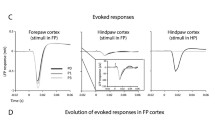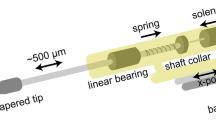Abstract
The somatosensory cortex of adult mammals has been shown to have a capacity to reorganize when inputs are removed by cutting afferent nerves or amputating a part of the body1–7. The area of cortex that would normally respond to stimulation of the missing input can become responsive to inputs from other parts of the body surface. Although a few animals have been studied with repeat recording1,2, no attempt has been made to follow the time-course of changes at cortical loci and the immediate effects of a small amputation have not been reported. We have followed the changes in response in the primary somatosensory cortex in the flying-fox following amputation of the single exposed digit on the forelimb. Immediately after amputation, neurons in the area of cortex receiving inputs from the missing digit were not silent but responded to stimulation of adjoining regions of the digit, hand, arm and wing. In the week following amputation, the enlarged receptive fields shrank until they covered only the skin around the amputation wound. The immediate response is interpreted as a removal of inhibition and the subsequent shrinking of the field may be due to re-establishment of the inhibitory balance in the affected cortex and its inputs.
Similar content being viewed by others
References
Merzenich, M. M. et al. Neuroscience 10, 639–665 (1983).
Merzenich, M. M. et al. J. comp. Neurol. 224, 591–605 (1984).
Franck, J. I. Brain Res. 186, 458–462 (1980).
Rasmusson, D. D. J. comp. Neurol. 205, 313–326 (1982).
Kelahan, A. M. & Doetsch, G. S. Somatosensory Res. 2, 49–81 (1984).
Wall, J. T. & Cusick, C. G. J. Neurosci. 4, 1499–1515 (1984).
Kalaska, J. & Pomeranz, B. J. Neurophysiol. 42, 618–633 (1979).
Calford, M. B., Graydon, M. N., Huerta, M. F., Kaas, J. H. & Pettigrew, J. D. Nature 313, 477–479 (1985).
Dykes, R. W. Brain Res. Rev. 6, 57–115 (1983).
Jänig, W., Schoultz, T. & Spencer, W. A. J. Neurophysiol 40, 822–835 (1977).
Jänig, W., Spencer, W. A. & Younkin, S. G. J. Neurophysiol. 42, 1450–1460 (1979).
Laskin, S. E. & Spencer, W. A. J. Neurophysiol 42, 1061–1082 (1979).
Hicks, T. P. & Dykes, R. W. Brain Res. 274, 160–164 (1983).
Metzler, J. & Marks, P. S. Brain Res. 177, 379–383 (1979).
Meizenich, M. M. et al. J. comp. Neurol. 258, 281–296 (1987).
Author information
Authors and Affiliations
Rights and permissions
About this article
Cite this article
Calford, M., Tweedale, R. Immediate and chronic changes in responses of somatosensory cortex in adult flying-fox after digit amputation. Nature 332, 446–448 (1988). https://doi.org/10.1038/332446a0
Received:
Accepted:
Issue Date:
DOI: https://doi.org/10.1038/332446a0
- Springer Nature Limited
This article is cited by
-
Adaptive analysis of cortical plasticity with fMRI in full face and arm transplants
Brain Imaging and Behavior (2021)
-
Organisation of the motor cortex differs between people with and without knee osteoarthritis
Arthritis Research & Therapy (2015)
-
Spinal mechanisms underlying potentiation of hindpaw responses observed after transient hindpaw ischemia in mice
Scientific Reports (2015)
-
Increased cortical responses to forepaw stimuli immediately after peripheral deafferentation of hindpaw inputs
Scientific Reports (2014)
-
Cholinergic Receptor Alterations in the Brain Stem of Spinal Cord Injured Rats
Neurochemical Research (2013)





